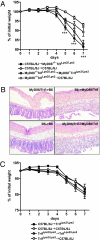MyD88 signaling in nonhematopoietic cells protects mice against induced colitis by regulating specific EGF receptor ligands
- PMID: 21041656
- PMCID: PMC2993336
- DOI: 10.1073/pnas.1014669107
MyD88 signaling in nonhematopoietic cells protects mice against induced colitis by regulating specific EGF receptor ligands
Abstract
Toll-like receptors (TLRs) trigger intestinal inflammation when the epithelial barrier is breached by physical trauma or pathogenic microbes. Although it has been shown that TLR-mediated signals are ultimately protective in models of acute intestinal inflammation [such as dextran sulfate sodium (DSS)-induced colitis], it is less clear which cells mediate protection. Here we demonstrate that TLR signaling in the nonhematopoietic compartment confers protection in acute DSS-induced colitis. Epithelial cells of MyD88/Trif-deficient mice express diminished levels of the epidermal growth factor receptor (EGFR) ligands amphiregulin (AREG) and epiregulin (EREG), and systemic lipopolysaccharide administration induces their expression in the colon. N-ethyl-N-nitrosourea (ENU)-induced mutations in Adam17 (which is required for AREG and EREG processing) and in Egfr both produce a strong DSS colitis phenotype, and the Adam17 mutation exerts its deleterious effect in the nonhematopoietic compartment. The effect of abrogation of TLR signaling is mitigated by systemic administration of AREG. A TLR→MyD88→AREG/EREG→EGFR signaling pathway is represented in nonhematopoietic cells of the intestinal tract, responds to microbial stimuli once barriers are breached, and mediates protection against DSS-induced colitis.
Conflict of interest statement
The authors declare no conflict of interest.
Figures



References
-
- Podolsky DK. Inflammatory bowel disease. N Engl J Med. 2002;347:417–429. - PubMed
-
- Xavier RJ, Podolsky DK. Unravelling the pathogenesis of inflammatory bowel disease. Nature. 2007;448:427–434. - PubMed
-
- Sartor RB. Mechanisms of disease: Pathogenesis of Crohn's disease and ulcerative colitis. Nat Clin Pract Gastroenterol Hepatol. 2006;3:390–407. - PubMed
-
- Rakoff-Nahoum S, Paglino J, Eslami-Varzaneh F, Edberg S, Medzhitov R. Recognition of commensal microflora by Toll-like receptors is required for intestinal homeostasis. Cell. 2004;118:229–241. - PubMed
Publication types
MeSH terms
Substances
Grants and funding
LinkOut - more resources
Full Text Sources
Other Literature Sources
Molecular Biology Databases
Research Materials
Miscellaneous

